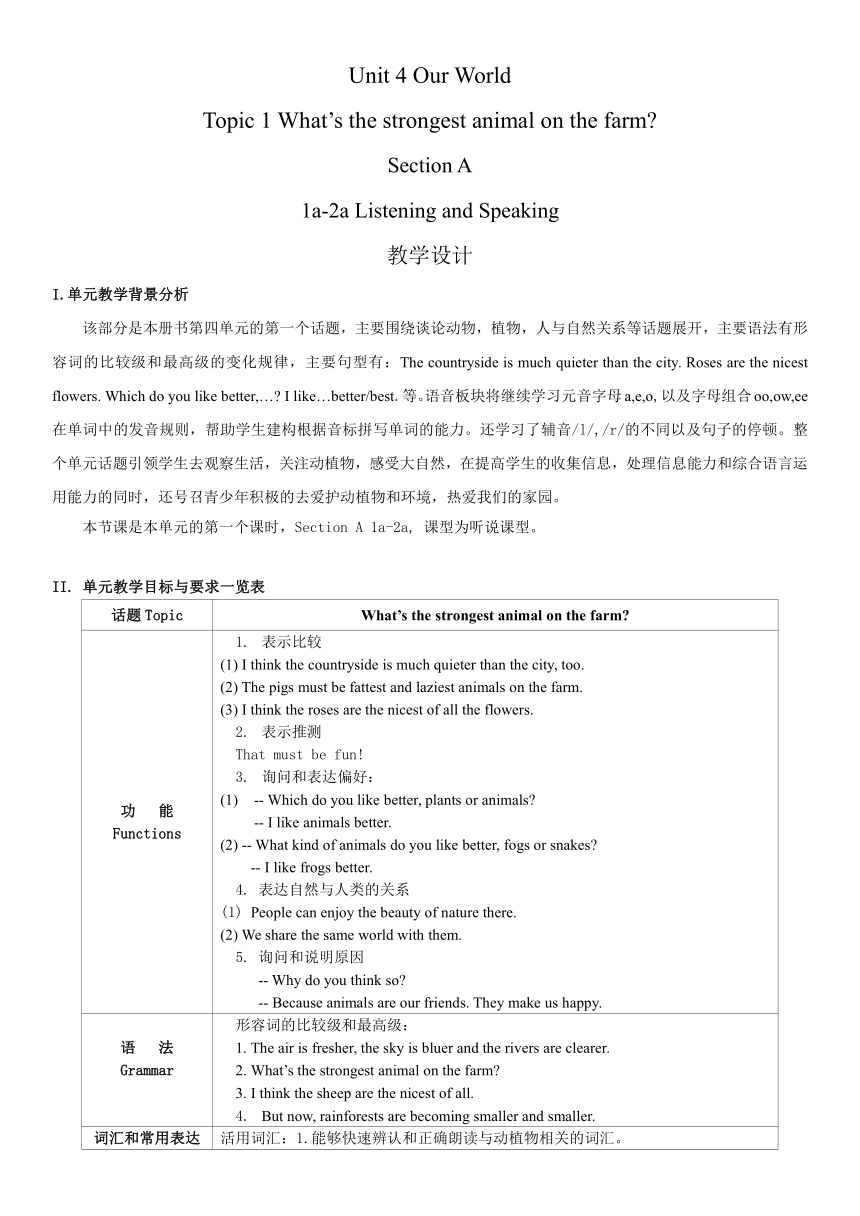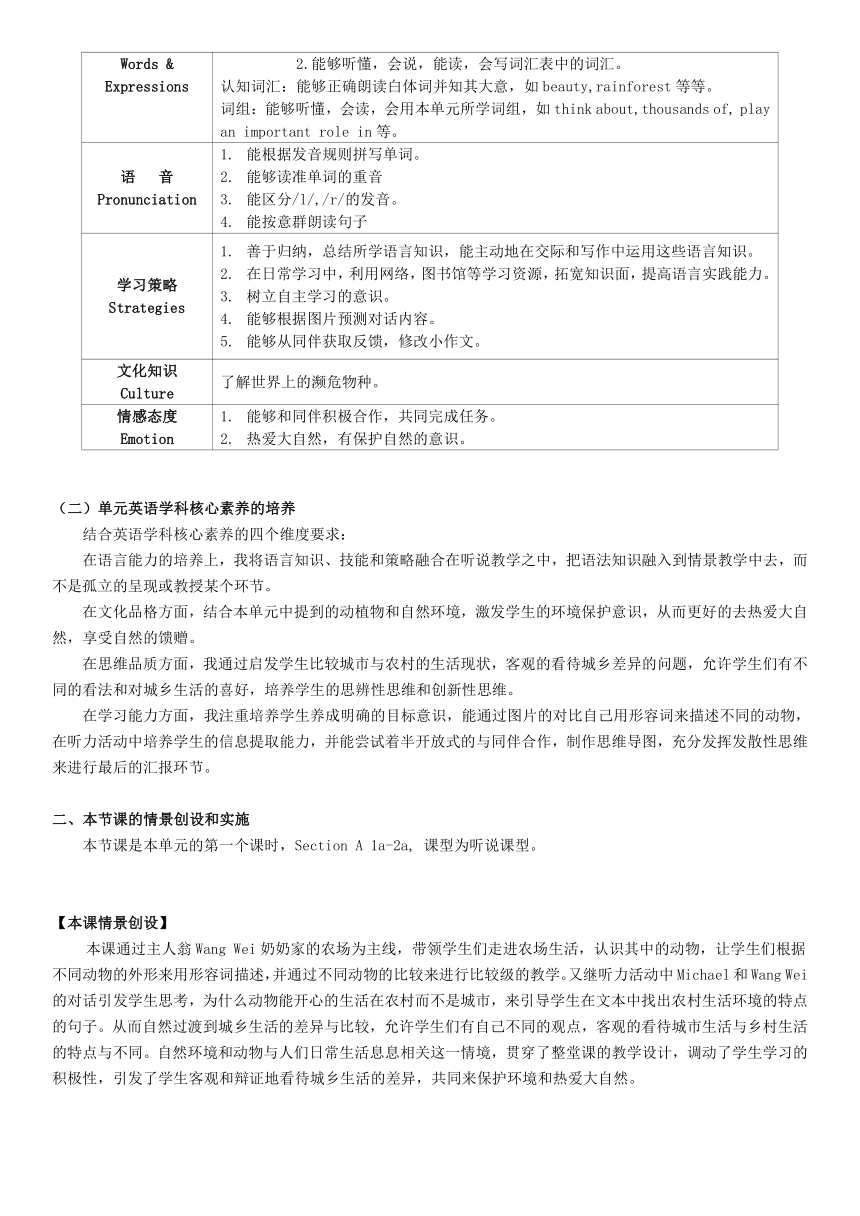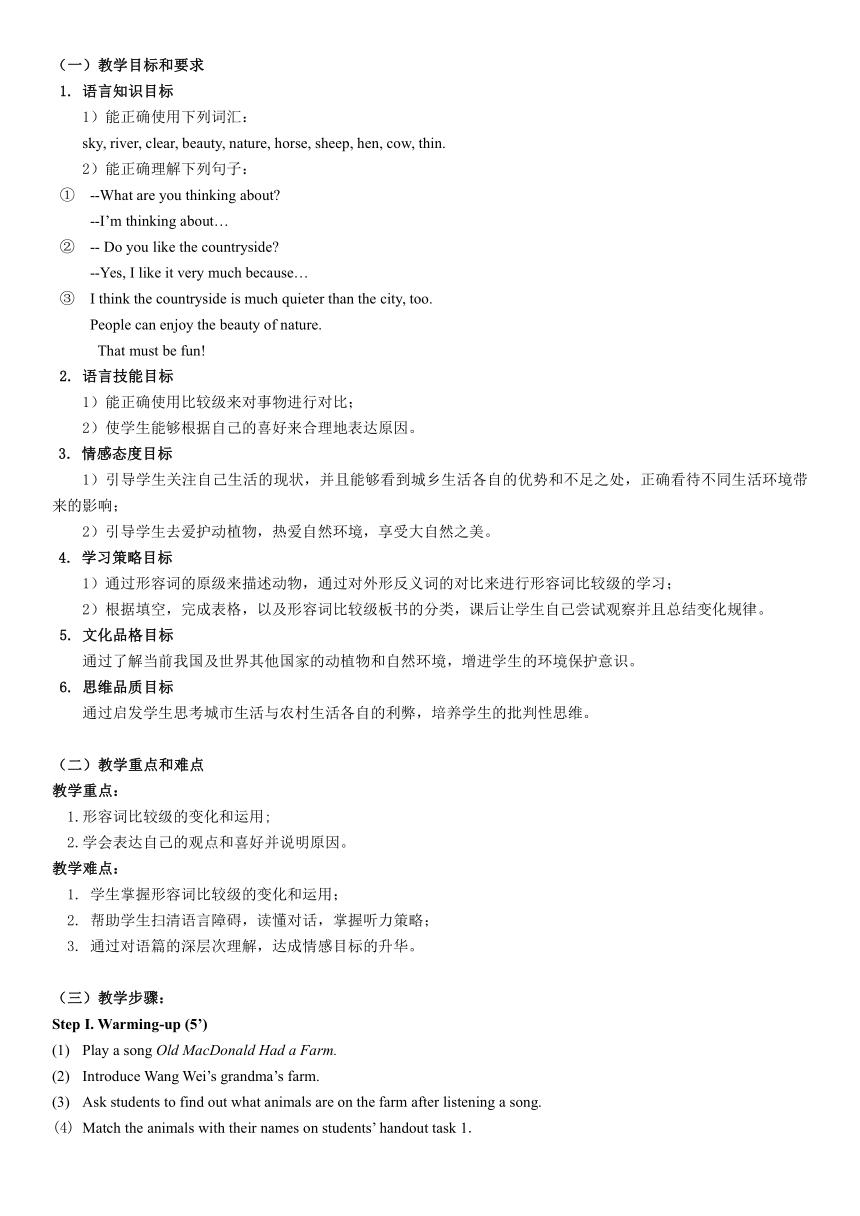仁爱科普版八年级上册 Unit4 Our World Topic1 SectionA 教案
文档属性
| 名称 | 仁爱科普版八年级上册 Unit4 Our World Topic1 SectionA 教案 |  | |
| 格式 | doc | ||
| 文件大小 | 108.0KB | ||
| 资源类型 | 教案 | ||
| 版本资源 | 仁爱科普版 | ||
| 科目 | 英语 | ||
| 更新时间 | 2022-10-14 08:44:49 | ||
图片预览



文档简介
Unit 4 Our World
Topic 1 What’s the strongest animal on the farm
Section A
1a-2a Listening and Speaking
教学设计
I.单元教学背景分析
该部分是本册书第四单元的第一个话题,主要围绕谈论动物,植物,人与自然关系等话题展开,主要语法有形容词的比较级和最高级的变化规律,主要句型有:The countryside is much quieter than the city. Roses are the nicest flowers. Which do you like better,… I like…better/best.等。语音板块将继续学习元音字母a,e,o,以及字母组合oo,ow,ee在单词中的发音规则,帮助学生建构根据音标拼写单词的能力。还学习了辅音/l/,/r/的不同以及句子的停顿。整个单元话题引领学生去观察生活,关注动植物,感受大自然,在提高学生的收集信息,处理信息能力和综合语言运用能力的同时,还号召青少年积极的去爱护动植物和环境,热爱我们的家园。
本节课是本单元的第一个课时,Section A 1a-2a, 课型为听说课型。
II. 单元教学目标与要求一览表
话题Topic What’s the strongest animal on the farm
功 能Functions 表示比较(1) I think the countryside is much quieter than the city, too.(2) The pigs must be fattest and laziest animals on the farm.(3) I think the roses are the nicest of all the flowers.表示推测That must be fun!询问和表达偏好: -- Which do you like better, plants or animals -- I like animals better.(2) -- What kind of animals do you like better, fogs or snakes -- I like frogs better.4. 表达自然与人类的关系(1) People can enjoy the beauty of nature there.(2) We share the same world with them. 5. 询问和说明原因 -- Why do you think so -- Because animals are our friends. They make us happy.
语 法Grammar 形容词的比较级和最高级:The air is fresher, the sky is bluer and the rivers are clearer.What’s the strongest animal on the farm I think the sheep are the nicest of all.But now, rainforests are becoming smaller and smaller.
词汇和常用表达Words & Expressions 活用词汇:1.能够快速辨认和正确朗读与动植物相关的词汇。 2.能够听懂,会说,能读,会写词汇表中的词汇。认知词汇:能够正确朗读白体词并知其大意,如beauty,rainforest等等。词组:能够听懂,会读,会用本单元所学词组,如think about,thousands of, play an important role in等。
语 音Pronunciation 能根据发音规则拼写单词。能够读准单词的重音能区分/l/,/r/的发音。能按意群朗读句子
学习策略Strategies 善于归纳,总结所学语言知识,能主动地在交际和写作中运用这些语言知识。在日常学习中,利用网络,图书馆等学习资源,拓宽知识面,提高语言实践能力。树立自主学习的意识。能够根据图片预测对话内容。能够从同伴获取反馈,修改小作文。
文化知识Culture 了解世界上的濒危物种。
情感态度Emotion 能够和同伴积极合作,共同完成任务。热爱大自然,有保护自然的意识。
(二)单元英语学科核心素养的培养
结合英语学科核心素养的四个维度要求:
在语言能力的培养上,我将语言知识、技能和策略融合在听说教学之中,把语法知识融入到情景教学中去,而不是孤立的呈现或教授某个环节。
在文化品格方面,结合本单元中提到的动植物和自然环境,激发学生的环境保护意识,从而更好的去热爱大自然,享受自然的馈赠。
在思维品质方面,我通过启发学生比较城市与农村的生活现状,客观的看待城乡差异的问题,允许学生们有不同的看法和对城乡生活的喜好,培养学生的思辨性思维和创新性思维。
在学习能力方面,我注重培养学生养成明确的目标意识,能通过图片的对比自己用形容词来描述不同的动物,在听力活动中培养学生的信息提取能力,并能尝试着半开放式的与同伴合作,制作思维导图,充分发挥发散性思维来进行最后的汇报环节。
二、本节课的情景创设和实施
本节课是本单元的第一个课时,Section A 1a-2a, 课型为听说课型。
【本课情景创设】
本课通过主人翁Wang Wei奶奶家的农场为主线,带领学生们走进农场生活,认识其中的动物,让学生们根据不同动物的外形来用形容词描述,并通过不同动物的比较来进行比较级的教学。又继听力活动中Michael和Wang Wei的对话引发学生思考,为什么动物能开心的生活在农村而不是城市,来引导学生在文本中找出农村生活环境的特点的句子。从而自然过渡到城乡生活的差异与比较,允许学生们有自己不同的观点,客观的看待城市生活与乡村生活的特点与不同。自然环境和动物与人们日常生活息息相关这一情境,贯穿了整堂课的教学设计,调动了学生学习的积极性,引发了学生客观和辩证地看待城乡生活的差异,共同来保护环境和热爱大自然。
(一)教学目标和要求
1. 语言知识目标
1)能正确使用下列词汇:
sky, river, clear, beauty, nature, horse, sheep, hen, cow, thin.
2)能正确理解下列句子:
① --What are you thinking about
--I’m thinking about…
② -- Do you like the countryside
--Yes, I like it very much because…
③ I think the countryside is much quieter than the city, too.
People can enjoy the beauty of nature.
That must be fun!
2. 语言技能目标
1)能正确使用比较级来对事物进行对比;
2)使学生能够根据自己的喜好来合理地表达原因。
3. 情感态度目标
1)引导学生关注自己生活的现状,并且能够看到城乡生活各自的优势和不足之处,正确看待不同生活环境带来的影响;
2)引导学生去爱护动植物,热爱自然环境,享受大自然之美。
4. 学习策略目标
1)通过形容词的原级来描述动物,通过对外形反义词的对比来进行形容词比较级的学习;
2)根据填空,完成表格,以及形容词比较级板书的分类,课后让学生自己尝试观察并且总结变化规律。
5. 文化品格目标
通过了解当前我国及世界其他国家的动植物和自然环境,增进学生的环境保护意识。
6. 思维品质目标
通过启发学生思考城市生活与农村生活各自的利弊,培养学生的批判性思维。
(二)教学重点和难点
教学重点:
1.形容词比较级的变化和运用;
2.学会表达自己的观点和喜好并说明原因。
教学难点:
1. 学生掌握形容词比较级的变化和运用;
2. 帮助学生扫清语言障碍,读懂对话,掌握听力策略;
3. 通过对语篇的深层次理解,达成情感目标的升华。
(三)教学步骤:
Step I. Warming-up (5’)
(1) Play a song Old MacDonald Had a Farm.
(2) Introduce Wang Wei’s grandma’s farm.
(3) Ask students to find out what animals are on the farm after listening a song.
(4) Match the animals with their names on students’ handout task 1.
(设计意图: 通过本课的主人翁Wang Wei为主线,创设出他奶奶家的农场这一情景,邀请大家一起走进农场生活,去认识农场上生活的不同的动物。让学生有亲切感,激发学生学习兴趣,从而更快的进入课堂学习的主题。)
Step II. Presentation.(8’)
(1) Show some pictures of animals and let students use some adjectives to describe them.
tall or short small or large heavy or thin
(2) Make a sentence of each animal by using the adjective.
A cow is short.
A horse is tall.
(3) Compare two different kinds of animals by using comparative degree.
A cow is shorter than a horse.
A horse is taller than a cow.
(4) Complete the sentence on students’ handout task 2.
(设计意图: 本环节采取图片到词,从词到简单句,又到两个动物进行对比的比较级的运用, 词不离句,在句子中教授新的单词,语言技能设置层层递进。 在比较级的两个句型中, 由第一幅幻灯片当中的填形容词,到第二幅填be动词和形容词, 再到第三幅的把主语后的句子补充完整,学生学习任务的设置也实现了由不开放—半开放—全开放这样一个循序渐进的过程和难度的创设。)
Step III. Listening (12’)
2a.
(1) Pre-listening
Ask the students to read all the words after the teacher.
(2) While-listening
circle the words they hear in the conversation and fill the blanks with the words they circled.
(3) Post-listening
Think about the question: Why do animals live a better life in the countryside
1a.
(1) Pre-listening
Let the students to read the four sentences in the box and explain the key words and expressions to them.
(2) While-listening
Listen to the conversation between Wang Wei and Michael, and fill in the blanks with the right sentences.
(3) Post-listening
Think about a question: Does Wang Wei like the life in the countryside Why
(设计意图:两篇听力都设计了听前,听中和听后活动,既让听力任务的设计有了由易到难的坡度,并且在听的过程中教会学生们听力部分的策略。听后活动的问题的设置也为下一步的教学环节做了充分的铺垫。)
Step IV. Pair work (8’)
(1) Discuss with your partner and finish the mind map of Life in the countryside.
(2) Discuss with your partner and finish the mind map of Life in the city.
(3) Finish the mind maps in pairs on the blackboard.
(设计意图:通过两人一组和同伴的讨论来总结出乡村生活和城市生活的特点,并用思维导图的方式进行呈现,让学生们的思路在讨论的过程中得以拓展而后进行总结归纳,为下一步城乡生活的对比埋下伏笔。)
The air is ________________. The rivers are ______________.
The sky is _______________. The environment (环境) is ________________.
The _______ is/are _________. The _______ is/are _________.
The _______ is/are _________. The __________ is/are _________.
Step V. Group work(10’)
(1) Show the students the pictures of cities, ask them to describe the life in the city.
(2) Discuss with your group members where do you like to live, in the city or the countryside And tell the reasons.
(3) Work together to finish the short passage in task 5.
(4) Give a report to the whole class.
(设计目的:通过小组活动的形式,在更喜欢城市生活或乡村生活这个问题上大家各抒己见,鼓励学生敢于表达自己的真实想法,说出和别人不一样的观点并且阐明自己的理由,客观的去看待这两种生活的优点和不足,培养学生的批判性思维和创新性思维。)
Step VI. Summary (2’)
Encourage students to summarize the emotional attitudes in this lesson after learning.
板书设计
Unit 4 Our World
Topic 1 What’s the strongest animal on the farm
Section A
1a-2a Listening and Speaking
tall—taller large—larger heavy—heavier thin—thinner
short—shorter
small—smaller
The air is ________________. The rivers are ______________.
The sky is ______________. The environment (环境) is ________________.
The _______ is/are _________. The _______ is/are _________.
The _______ is/are _________. The __________ is/are _________.
Life in the countryside
Life in the city
Life in the countryside
Life in the city
Topic 1 What’s the strongest animal on the farm
Section A
1a-2a Listening and Speaking
教学设计
I.单元教学背景分析
该部分是本册书第四单元的第一个话题,主要围绕谈论动物,植物,人与自然关系等话题展开,主要语法有形容词的比较级和最高级的变化规律,主要句型有:The countryside is much quieter than the city. Roses are the nicest flowers. Which do you like better,… I like…better/best.等。语音板块将继续学习元音字母a,e,o,以及字母组合oo,ow,ee在单词中的发音规则,帮助学生建构根据音标拼写单词的能力。还学习了辅音/l/,/r/的不同以及句子的停顿。整个单元话题引领学生去观察生活,关注动植物,感受大自然,在提高学生的收集信息,处理信息能力和综合语言运用能力的同时,还号召青少年积极的去爱护动植物和环境,热爱我们的家园。
本节课是本单元的第一个课时,Section A 1a-2a, 课型为听说课型。
II. 单元教学目标与要求一览表
话题Topic What’s the strongest animal on the farm
功 能Functions 表示比较(1) I think the countryside is much quieter than the city, too.(2) The pigs must be fattest and laziest animals on the farm.(3) I think the roses are the nicest of all the flowers.表示推测That must be fun!询问和表达偏好: -- Which do you like better, plants or animals -- I like animals better.(2) -- What kind of animals do you like better, fogs or snakes -- I like frogs better.4. 表达自然与人类的关系(1) People can enjoy the beauty of nature there.(2) We share the same world with them. 5. 询问和说明原因 -- Why do you think so -- Because animals are our friends. They make us happy.
语 法Grammar 形容词的比较级和最高级:The air is fresher, the sky is bluer and the rivers are clearer.What’s the strongest animal on the farm I think the sheep are the nicest of all.But now, rainforests are becoming smaller and smaller.
词汇和常用表达Words & Expressions 活用词汇:1.能够快速辨认和正确朗读与动植物相关的词汇。 2.能够听懂,会说,能读,会写词汇表中的词汇。认知词汇:能够正确朗读白体词并知其大意,如beauty,rainforest等等。词组:能够听懂,会读,会用本单元所学词组,如think about,thousands of, play an important role in等。
语 音Pronunciation 能根据发音规则拼写单词。能够读准单词的重音能区分/l/,/r/的发音。能按意群朗读句子
学习策略Strategies 善于归纳,总结所学语言知识,能主动地在交际和写作中运用这些语言知识。在日常学习中,利用网络,图书馆等学习资源,拓宽知识面,提高语言实践能力。树立自主学习的意识。能够根据图片预测对话内容。能够从同伴获取反馈,修改小作文。
文化知识Culture 了解世界上的濒危物种。
情感态度Emotion 能够和同伴积极合作,共同完成任务。热爱大自然,有保护自然的意识。
(二)单元英语学科核心素养的培养
结合英语学科核心素养的四个维度要求:
在语言能力的培养上,我将语言知识、技能和策略融合在听说教学之中,把语法知识融入到情景教学中去,而不是孤立的呈现或教授某个环节。
在文化品格方面,结合本单元中提到的动植物和自然环境,激发学生的环境保护意识,从而更好的去热爱大自然,享受自然的馈赠。
在思维品质方面,我通过启发学生比较城市与农村的生活现状,客观的看待城乡差异的问题,允许学生们有不同的看法和对城乡生活的喜好,培养学生的思辨性思维和创新性思维。
在学习能力方面,我注重培养学生养成明确的目标意识,能通过图片的对比自己用形容词来描述不同的动物,在听力活动中培养学生的信息提取能力,并能尝试着半开放式的与同伴合作,制作思维导图,充分发挥发散性思维来进行最后的汇报环节。
二、本节课的情景创设和实施
本节课是本单元的第一个课时,Section A 1a-2a, 课型为听说课型。
【本课情景创设】
本课通过主人翁Wang Wei奶奶家的农场为主线,带领学生们走进农场生活,认识其中的动物,让学生们根据不同动物的外形来用形容词描述,并通过不同动物的比较来进行比较级的教学。又继听力活动中Michael和Wang Wei的对话引发学生思考,为什么动物能开心的生活在农村而不是城市,来引导学生在文本中找出农村生活环境的特点的句子。从而自然过渡到城乡生活的差异与比较,允许学生们有自己不同的观点,客观的看待城市生活与乡村生活的特点与不同。自然环境和动物与人们日常生活息息相关这一情境,贯穿了整堂课的教学设计,调动了学生学习的积极性,引发了学生客观和辩证地看待城乡生活的差异,共同来保护环境和热爱大自然。
(一)教学目标和要求
1. 语言知识目标
1)能正确使用下列词汇:
sky, river, clear, beauty, nature, horse, sheep, hen, cow, thin.
2)能正确理解下列句子:
① --What are you thinking about
--I’m thinking about…
② -- Do you like the countryside
--Yes, I like it very much because…
③ I think the countryside is much quieter than the city, too.
People can enjoy the beauty of nature.
That must be fun!
2. 语言技能目标
1)能正确使用比较级来对事物进行对比;
2)使学生能够根据自己的喜好来合理地表达原因。
3. 情感态度目标
1)引导学生关注自己生活的现状,并且能够看到城乡生活各自的优势和不足之处,正确看待不同生活环境带来的影响;
2)引导学生去爱护动植物,热爱自然环境,享受大自然之美。
4. 学习策略目标
1)通过形容词的原级来描述动物,通过对外形反义词的对比来进行形容词比较级的学习;
2)根据填空,完成表格,以及形容词比较级板书的分类,课后让学生自己尝试观察并且总结变化规律。
5. 文化品格目标
通过了解当前我国及世界其他国家的动植物和自然环境,增进学生的环境保护意识。
6. 思维品质目标
通过启发学生思考城市生活与农村生活各自的利弊,培养学生的批判性思维。
(二)教学重点和难点
教学重点:
1.形容词比较级的变化和运用;
2.学会表达自己的观点和喜好并说明原因。
教学难点:
1. 学生掌握形容词比较级的变化和运用;
2. 帮助学生扫清语言障碍,读懂对话,掌握听力策略;
3. 通过对语篇的深层次理解,达成情感目标的升华。
(三)教学步骤:
Step I. Warming-up (5’)
(1) Play a song Old MacDonald Had a Farm.
(2) Introduce Wang Wei’s grandma’s farm.
(3) Ask students to find out what animals are on the farm after listening a song.
(4) Match the animals with their names on students’ handout task 1.
(设计意图: 通过本课的主人翁Wang Wei为主线,创设出他奶奶家的农场这一情景,邀请大家一起走进农场生活,去认识农场上生活的不同的动物。让学生有亲切感,激发学生学习兴趣,从而更快的进入课堂学习的主题。)
Step II. Presentation.(8’)
(1) Show some pictures of animals and let students use some adjectives to describe them.
tall or short small or large heavy or thin
(2) Make a sentence of each animal by using the adjective.
A cow is short.
A horse is tall.
(3) Compare two different kinds of animals by using comparative degree.
A cow is shorter than a horse.
A horse is taller than a cow.
(4) Complete the sentence on students’ handout task 2.
(设计意图: 本环节采取图片到词,从词到简单句,又到两个动物进行对比的比较级的运用, 词不离句,在句子中教授新的单词,语言技能设置层层递进。 在比较级的两个句型中, 由第一幅幻灯片当中的填形容词,到第二幅填be动词和形容词, 再到第三幅的把主语后的句子补充完整,学生学习任务的设置也实现了由不开放—半开放—全开放这样一个循序渐进的过程和难度的创设。)
Step III. Listening (12’)
2a.
(1) Pre-listening
Ask the students to read all the words after the teacher.
(2) While-listening
circle the words they hear in the conversation and fill the blanks with the words they circled.
(3) Post-listening
Think about the question: Why do animals live a better life in the countryside
1a.
(1) Pre-listening
Let the students to read the four sentences in the box and explain the key words and expressions to them.
(2) While-listening
Listen to the conversation between Wang Wei and Michael, and fill in the blanks with the right sentences.
(3) Post-listening
Think about a question: Does Wang Wei like the life in the countryside Why
(设计意图:两篇听力都设计了听前,听中和听后活动,既让听力任务的设计有了由易到难的坡度,并且在听的过程中教会学生们听力部分的策略。听后活动的问题的设置也为下一步的教学环节做了充分的铺垫。)
Step IV. Pair work (8’)
(1) Discuss with your partner and finish the mind map of Life in the countryside.
(2) Discuss with your partner and finish the mind map of Life in the city.
(3) Finish the mind maps in pairs on the blackboard.
(设计意图:通过两人一组和同伴的讨论来总结出乡村生活和城市生活的特点,并用思维导图的方式进行呈现,让学生们的思路在讨论的过程中得以拓展而后进行总结归纳,为下一步城乡生活的对比埋下伏笔。)
The air is ________________. The rivers are ______________.
The sky is _______________. The environment (环境) is ________________.
The _______ is/are _________. The _______ is/are _________.
The _______ is/are _________. The __________ is/are _________.
Step V. Group work(10’)
(1) Show the students the pictures of cities, ask them to describe the life in the city.
(2) Discuss with your group members where do you like to live, in the city or the countryside And tell the reasons.
(3) Work together to finish the short passage in task 5.
(4) Give a report to the whole class.
(设计目的:通过小组活动的形式,在更喜欢城市生活或乡村生活这个问题上大家各抒己见,鼓励学生敢于表达自己的真实想法,说出和别人不一样的观点并且阐明自己的理由,客观的去看待这两种生活的优点和不足,培养学生的批判性思维和创新性思维。)
Step VI. Summary (2’)
Encourage students to summarize the emotional attitudes in this lesson after learning.
板书设计
Unit 4 Our World
Topic 1 What’s the strongest animal on the farm
Section A
1a-2a Listening and Speaking
tall—taller large—larger heavy—heavier thin—thinner
short—shorter
small—smaller
The air is ________________. The rivers are ______________.
The sky is ______________. The environment (环境) is ________________.
The _______ is/are _________. The _______ is/are _________.
The _______ is/are _________. The __________ is/are _________.
Life in the countryside
Life in the city
Life in the countryside
Life in the city
同课章节目录
- Unit 1 Playing Sports
- Topic 1 I'm going to play basketball.
- Topic 2 I'll kick you the ball again.
- Topic 3 The school sports meet is coming.
- Unit 2 Keeping Healthy
- Topic 1 You should brush your teeth twice a day.
- Topic 2 I must ask him to give up smoking.
- Topic 3 Must we exercise to prevent the flu?
- Unit 3 Our Hobbies
- Topic 1 What's your hobby?
- Topic 2 What sweet music!
- Topic 3 What were you doing at this time yesterday
- Unit 4 Our World
- Topic 1 What's the strongest animal on the farm?
- Topic 2 How can we protect ourselves from the eart
- Topic 3 The Internet makes the world smaller.
